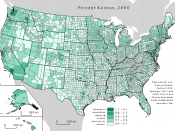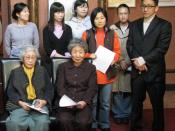Korean Americans � PAGE �1�
A Definition and Description of the Topic
Korea is divided in to parts, North Korea and South Korea. South Korea's official name is the Republic of Korea, but its national name is Taehan Min'guk. The following information and statistics came from the Korean Statistical Information Service.
Land area: 37,911 sq mi (98,189 sq km)
Population (2007 est.): 49,044,790 (growth rate: 0.4%); birth rate: 9.9/1000; infant mortality rate: 6.1/1000; life expectancy: 77.2; density per sq mi: 1,294
Capital and largest city (2003 est.): Seoul, 10,287,847 (city proper)
Other large cities: Pusan, 3,504,900; Inchon, 2,479,600 (part of Seoul metro. area); Taegu, 2,369,800
Monetary unit: won
Languages: Korean, English widely taught
Ethnicity/race: homogeneous (except for about 20,000 Chinese)
Religions: no affiliation 46%, Christian 26%, Buddhist 26%, Confucianist 1%, other 1%
Economic summary: GDP/PPP (2007 est.): $1.206 trillion; per capita $24,600. Real growth rate: 4.9%. Inflation: 2.5%. Unemployment: 3.2%.
Arable land: 17%. Agriculture: rice, root crops, barley, vegetables, fruit; cattle, pigs, chickens, milk, eggs; fish. Labor force: 23.99 million; agriculture 3.2%, industry 39.6%, services 57.2%. Industries: electronics, telecommunications, automobile production, chemicals, shipbuilding, steel. Natural resources: coal, tungsten, graphite, molybdenum, lead, hydropower potential. Exports: $371.5 billion f.o.b. (2007 est.): semiconductors, wireless telecommunications equipment, motor vehicles, computers, steel, ships, petrochemicals. Imports: $356.8 billion f.o.b. (2007 est.): machinery, electronics and electronic equipment, oil, steel, transport equipment, organic chemicals, plastics. Major trading partners: China, U.S., Japan, Hong Kong, Saudi Arabia (2004).
Communications: Telephones: main lines in use: 26.866 million (2006); mobile cellular: 40.197 million (2006). Radio broadcast stations: AM 61, FM 150, shortwave 2 (2005). Radios: 47.5 million (2000). Television broadcast stations: 43 (plus 59 cable operators and 190 relay cable operators)(2005). Televisions: 15.9 million (1997). Internet Service Providers (ISPs): 315,537 (2007). Internet users: 34.12 million (2006).
Transportation: Railways: total: 3,472 km...


